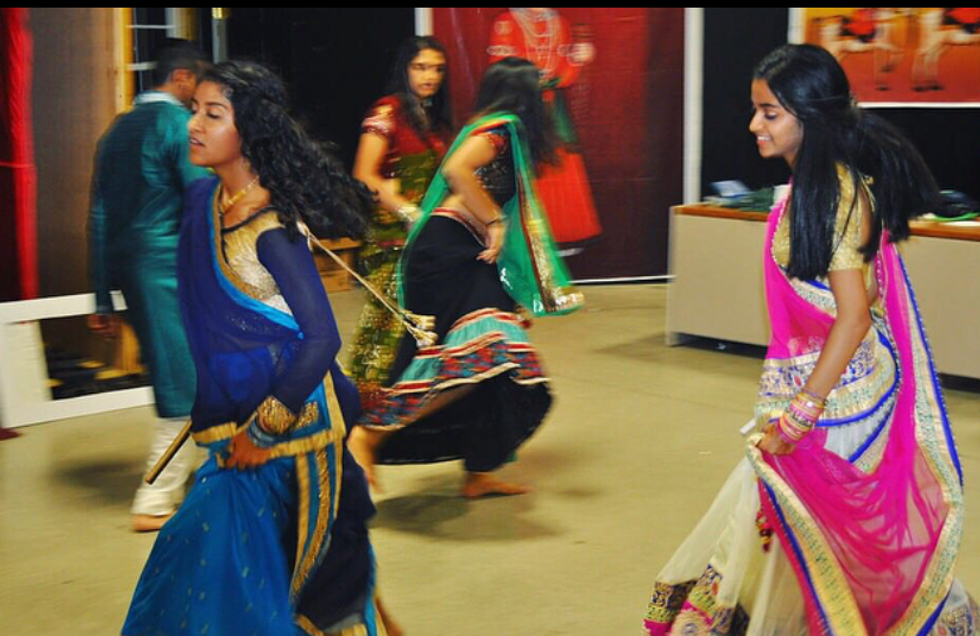My feet move to the beat of the drums, a seeming blur with a mind of their own. The vibrancy of my chaniya choli flashes against the bland bamboo of the gym floor as I twirl in circles. One, two, three, four times I circle the gym until I lose count of how many times I have gone around. I can feel the blisters rapidly forming on my feet and sweat dripping down every inch of my body. I am doing garba, and I am having the time of my life.
Some people enjoy the holiday season around wintertime, while others await the sunny days of summer; my favorite season, however, is garba season. Garba, a traditional Gujarati folk dance, takes place during the Hindu festival of Navratri (näv'•rät•ri). "Nav" meaning nine and "ratri" meaning nights in Sanskrit, Navratri is the nine day celebration of the goddess Durga and her nine avatars defeating the demon Mahishasura. It is a celebration of the victory of good over evil as well as a recognition of the power of the female form. In the Indian state of Gujarat, where my family is from, Navratri is celebrated with spiritual worship, music, and, my personal favorite, the traditional folk dance, garba. Although Navratri is only a nine day celebration, garbas in the US take place every weekend from the end of September to mid-October. In the US, garba events are usually held in large spaces such as high school gyms, recreational centers, and occasionally places as big as football stadiums.
The traditional clothing that women usually wear is called a "chaniya choli" which consist of a blouse, a skirt and an "odni" or drape. People accessorize with jewelry and matching "bangri" or bangles. Men usually wear simpler clothing, like a "jabho" or "kurta," which are long tunics.
The tradition of garba involves people dancing in concentric circles around an ornamented pot or lamp to Gujarati folk music. People form lines performing different dance patterns, bending and sweeping gracefully in some and jumping and clapping energetically in others. There is usually a brief puja (poo•ja), or religious ceremony in between rounds of garba. The night usually ends with a section of raas/dandiya which is where we use sticks while we dance. Indian-American teenagers, such as myself, have modernized garba, creating our own steps and patterns. I am constantly looking to learn new steps from my friends and others around me: the more I know, the more fun and more interesting it gets.
Surprisingly, I wasn't always such a big fan of garba. As a child, I used to dread dressing up and being dragged to high school gymnasiums every weekend during Navratri. Eventually, I got bored pouting on the bleachers, envying the high school students who came dressed up with their friends, performing complicated, yet fashionable steps. I soon realized that I also wanted to enjoy celebrating my culture.
Fast forward a couple years, and you will find me dancing my heart out at garba every Navratri. The feeling of dancing in a unique pattern, leading a garba line, knowing that I am synchronized with the beat of the drums and the people behind me, is unparalleled. Through garba, I develop a remarkable connection with everyone around me, which is a major factor in my love for the event. I have a special appreciation for the moment when the tempo of the music picks up, causing people to shout and cheer in unison as they speed up to match the beat of the drums.
The style of garba in America is dramatically different from garba in India, something many people are weary of. Several of my older relatives have voiced their thoughts about how the Americanization and modernization of garba has diminished the rich culture and importance it holds. What they look down upon, however, I cherish. I love loaning my non-Gujarati friends chaniya cholis and bringing them to garba events with me, regardless of their ethnicity or culture.
The garba frenzy has even spread to colleges; many colleges have garba-raas teams that compete in a competitive circuit. Rutgers' RAGA is the competitive garba-raas team of the university; we travel around the country for competitions performing our routine with props, themes, etc.
For me garba is more than a cultural tradition; it has instilled confidence in me and has allowed me to immerse myself in my culture, and even teach others about it. Being on a competitive team has also given me immense joy because I am able to integrate this part of my culture into my everyday life.


















